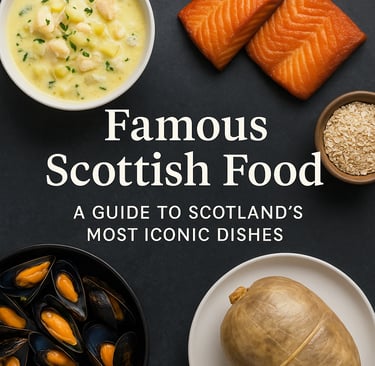Traditional Scottish Seafood
Traditional Scottish Seafood: A Personal Journey Through Scotland’s Coastal Delicacies
FOOD
9/3/20254 min read


Traditional Scottish Seafood: A Personal Journey Through Scotland’s Coastal Delicacies
Introduction
Traditional Scottish Seafood is woven into the fabric of Britain’s coastal culture and is gaining new fans worldwide. Growing up near the Scottish Borders, my earliest memories include visiting Aberdeen with my father to sample the freshest langoustines straight off the boat. Traditional Scottish cuisine is much more than a collection of iconic dishes—it’s about legends, family traditions, and the relentless North Sea winds.
In this guide, I’ll walk you through the essentials of Scottish seafood cookery: its unique features, celebrated dishes, modern industry trends, and what makes Scottish seafood respected globally. Whether you’ve travelled the rugged Highlands or have never tasted a hand-dived scallop, I hope this journey inspires a deeper appreciation for Scotland’s maritime bounty.
What Makes Traditional Scottish Seafood Unique
Scotland’s pristine waters—stretching over 18,000 kilometres of coastline—create the perfect environment for seafood renowned for its freshness and flavour. According to Marine Scotland, the country produces over 480,000 tonnes of seafood annually, accounting for 61% of the UK’s total landings. What distinguishes Scottish seafood is not just quantity, but quality: cold, clean waters slow the growth of fish and shellfish, resulting in firmer flesh and nuanced flavours.
Cultural heritage is central. Fishing communities in the Highlands and Islands preserve ancient techniques such as hot-smoking salmon over whisky barrel chippings and hand-tying lobster pots. The recognition of products under the EU’s Protected Geographical Indication (PGI), like the Arbroath Smokie, underlines the authenticity preserved in every bite.
Sustainability is another cornerstone. Over 80% of Scottish fisheries are certified as sustainable or on a pathway to certification, placing Scotland at the forefront of responsible seafood production. Strict standards protect marine ecosystems and the livelihoods of over 5,000 people employed directly in the seafood sector.
Key Dishes, Destinations, and Their Stories
Hot-Smoked Salmon
Scottish salmon is the UK’s top food export, valued at over £600 million in 2022. The unique hot-smoking process infuses the fish with a delicate, smoky sweetness. Smokehouses in Loch Fyne welcome visitors to see this tradition in action.
“Scottish salmon’s fame isn’t luck. It’s the result of generations perfecting both farming and wild-catch practices,” says chef Fiona MacGillivray of the Edinburgh Seafood Society.
Cullen Skink
A hearty soup made from smoked haddock, potatoes, and onions, originally a meal for fishing crews. Today it symbolises comfort food across Scotland and the wider UK.
Arbroath Smokies
From the east coast town of Arbroath, these whole haddocks are salted and smoked over hardwood fires. PGI status protects their method and reputation.
Shetland Mussels and Hebridean Scallops
Cool, fast-moving currents produce some of Europe’s plumpest mussels and scallops. Around 8,000 tonnes of mussels are harvested annually in Shetland, with 70% exported.
Local Markets and Seafood Festivals
From Glasgow’s Merchant City Seafood Festival to harbour markets in Ullapool, community events showcase seafood culture. In Oban, I enjoyed oysters so fresh they still carried the taste of the sea air.
Comparison Table: Signature Scottish Seafood Dishes
Dish | Region | Main Ingredients | Protected Status
Hot-Smoked Salmon | Highlands & Islands | Salmon, wood smoke | Export PGI (pending)
Cullen Skink | Northeast (Cullen) | Smoked haddock, potato | No
Arbroath Smokie | East Coast (Arbroath) | Haddock, hardwood | PGI
Shetland Mussels | Shetland Isles | Blue mussels | No
Hebridean Scallops | Outer Hebrides | King scallops | No
Modern Trends and Sustainable Innovations
Scottish seafood today blends heritage with innovation.
Sustainable aquaculture now covers nearly all salmon farming sites, with integrated multi-trophic systems reducing impact by farming fish, shellfish, and seaweed together.
Marine Stewardship Council certification has expanded rapidly: 67% of landings carried MSC status in 2024 compared with 30% in 2015.
Exports continue to adapt to global markets, with Asia now receiving a growing share of Scottish shellfish.
Community-led projects such as the North Sea Fisheries Improvement Programme ensure local voices shape sustainable practices.
Core Features: Supply Chains, Provenance, and Quality Standards
• Short supply chains deliver seafood from landing to plate in under 24 hours.
• Provenance is guaranteed through the Scottish Quality Seafood (SQS) mark, with QR codes linking to vessel and catch date.
• Food Standards Scotland enforces strict hygiene and labelling rules: in 2023, 97% of processors achieved top ratings.
• Export compliance ensures Scottish seafood meets EU and international benchmarks.
• Generations of local families bring deep knowledge, maintaining quality and reputation.
My Take: Personal Insights
My own seafood journey began on the harbours of Eyemouth and deepened in Skye. Eating an Arbroath Smokie fresh from the smokehouse remains one of my clearest food memories—flaky, briny, and smoky in equal measure.
What makes Scottish seafood special is not only taste, but community. Families who have fished for centuries continue their craft, while young chefs reinterpret traditions. Speaking with a Shetland mussel farmer, I was struck by her words: “Our grandmothers’ recipes matter, but we also need to think about the next generation’s seas.”
Scottish seafood thrives on respect for provenance, a commitment to sustainability, and pride in tradition. When these elements combine, whether in a high-end Edinburgh restaurant or a village pub, the experience is unforgettable.
FAQs About Traditional Scottish Seafood
What is Traditional Scottish Seafood?
It refers to Scotland’s heritage of sourcing, preparing, and enjoying fish and shellfish, including dishes like Cullen Skink and Arbroath Smokies.
How is Scottish seafood different from other UK seafood?
Cool, clean waters and ancient traditions give Scottish products distinct quality. Over 60% of UK seafood is landed in Scotland.
Which Scottish seafood products have protected status?
The Arbroath Smokie has PGI recognition; Scottish farmed salmon has certifications pending.
Where can I sample authentic Scottish seafood?
Harbourside restaurants, city markets, and seafood festivals across Scotland. Look for the SQS mark.
Is Scottish seafood sustainable?
Yes. Over 80% of wild-caught and farmed products come from certified sustainable sources.
Why is Scottish seafood popular globally?
Its reputation for quality, sustainability, and heritage drives rising demand worldwide.
Conclusion and Next Steps
Traditional Scottish Seafood is more than food. It is a link between land, sea, and people. Ancient practices endure, but sustainability and innovation secure the future.
For travellers, visiting a seafood market, dining at a harbour pub, or joining a festival offers the best introduction. For home cooks, buying certified products brings a piece of Scotland’s coast into your kitchen.
Scotland’s waters provide not just nourishment but a story of community, heritage, and resilience. To taste traditional seafood here is to taste Scotland itself.
AUTHOR: Jamie MacGregor
Scottish food writer, seafood enthusiast, and former chef. Contributor to BBC Good Food and Scotland on Sunday.

